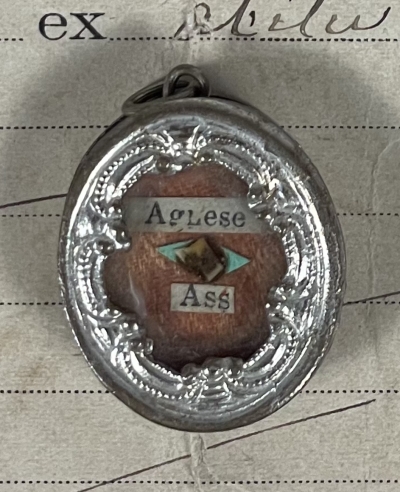Saint Agnes of Assisi (†1253) was a younger sister of St. Clare of Assisi and one of the first abbesses of the Order of Poor Ladies (now the Poor Clares). Her eldest sister Clare, inspired by the example of Francis of Assisi, left their father's home in secret to become a follower of Francis. Sixteen days later, Agnes ran off to the Church of St. Angelo di Panzo where Francis had brought her sister, resolved to share Clare's life of poverty and penance. Angry at the loss of two of his daughters, their father sent his brother Monaldo and several relatives and armed followers to the monastery to force Agnes, if persuasion failed, to return home. They dragged Agnes out of the monastery by her hair, striking and kicking her repeatedly. Agnes' body reportedly became so heavy that her assailants dropped her in a field nearby. Agnes' relatives, purportedly realizing that something divine protected her, allowed the sisters to remain together. Francis himself cut her hair and gave her the religious habit, in recognition of Agnes' dedication. Francis later established a cloister for Clare and Agnes at the rural chapel of San Damiano, where they were soon joined by other noblewomen of the city, and the Order of Poor Ladies, later known as the Poor Clares, began, with Clare as its abbess. In 1221, a group of Benedictine nuns in Monticelli near Florence asked to become Poor Ladies. Agnes was chosen to lead the new community. She later went on to establish other communities of the order, including those of Mantua, Venice, and Padua. Agnes was said to be very virtuous, and as abbess she ruled with a benevolent kindness, knowing how to make the practice of virtue appealing to her sisters. She was canonized in 1753, the year of her 500th anniversary and her feast day is celebrated on 16 November.
Oval white metal pendant reliquary theca housing the second-class ex Habitu (of a habit) relic of Saint Agnes of Assisi. A substantial relic is affixed to a silk ground asurrounded by gilt paperolle ornamentation and identified in Latin on manuscript cedula label as S Agnetes Ass. (Saint Agnes of Assisi). On the back, under a protective cap, the theca is secured with a seal of red Spanish wax bearing an imprint of a coat of arms of Fr. Mauro Bernardo Pietro Nardi O.F.M. Cap. (†), Titular Bishop of Thebae in Thebaide (1895-1911). The relic is accompanied by the original matching authentics document issued and sealed by the order of Bishop Nardiin 1901.
Additional Info
- ID#: 281-41-RSCR-225
- Size: 27 x 22 mm
- Age: ca. 1901
- Origin: Italy
- Materials: Metal, glass, silk, paper, Spanish wax
- Price: $2,000
Additional Images of this Item
Online Store & Services
Information
Quick Link
Information
Quick Link
SAVE 5% from your first purchase when you subscribe to receive our infrequent mailings with updates on new arrivals, exclusive offers, and fascinating stories on relevant subjects.








 Поменять язык на русский
Поменять язык на русский 